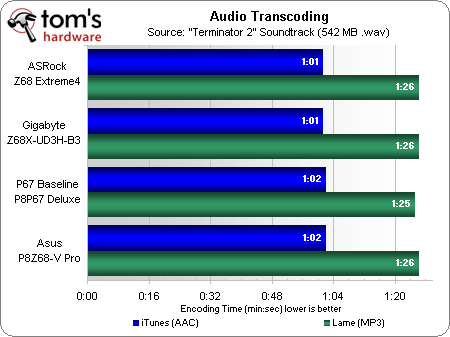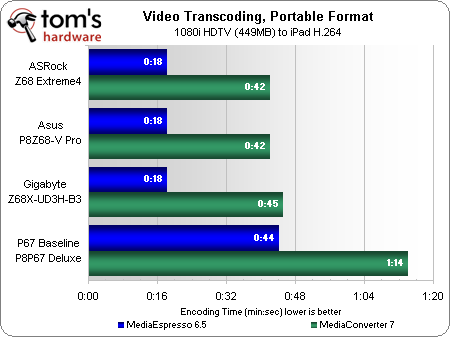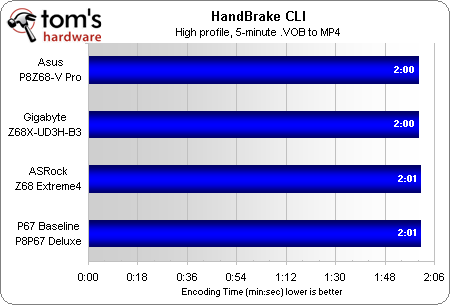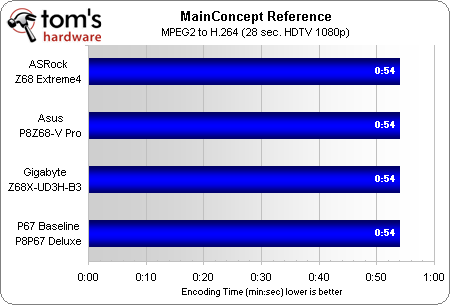Z68 Express Roundup: Three Motherboards Do Battle Around $200
Intel reserved its most feature-rich LGA 1155 platform for (or four?) months past the launch of its Sandy Bridge-based processors, but was it worth the wait? We compare three upper-mainstream Z68 examples to a top-quality P67 predecessor to find out.
Benchmark Results: Audio And Video Encoding
The P67 leads in Lame MP3 encoding, but loses to both Gigabyte and ASRock in iTunes. The difference is trivial and does not correlate to the Z68’s activated internal GPU.
Applications that use Intel’s integrated video decoder benefit greatly from the Z68’s ability to activate it. The P67 instead uses the Nvidia decoder in the above chart.
Curious about both GPU-assisted and software-based encoding and decoding, we tried every combination before presenting the optimized results above. The P67 platform employs Nvidia's CUDA-based encoding in MediaEspresso, but enabling its hardware decoder actually hurt performance. Thus, it was tested using software decode.
On the other hand, Intel’s GPU encoder was only slightly faster than software encoding. The superb performance seen above is mostly due to its extra-powerful decoder. The best transcoding times come from having both enabled.
Anyone lacking either of these features will want to know the transcode time via software-only mode. MediaEspresso slowed to 1:13, while MediaConverter slowed to 1:30. It appears CyberLink has done a better job of optimizing for GPU acceleration.
Relying on software encoding, HandBrake and MainConcept show negligible performance differences between motherboard models.
Get Tom's Hardware's best news and in-depth reviews, straight to your inbox.
Current page: Benchmark Results: Audio And Video Encoding
Prev Page Benchmark Results: Just Cause 2 And Metro 2033 Next Page Benchmark Results: Productivity-
Crashman user 18ASrock comes with 4 eSATA cables?KisakukuThe first UEFI screenshots for ASRock and Asus are switched.Fixed, thanks!Reply -
evga_fan ->ThomasReply
"Gigabyte’s Quick Boost application sets our processor at 200, 400, or 700 MHz beyond its rated frequency."
Just so you know. Anyways, keep up the good work!
Cheers -
crisan_tiberiu so, basicaly there is no difference in performance between theese boards as i can see.Reply -
hmm .. was thinking of getting an Asus P8Z68-V Pro .. not so sure now knowing that the other boards offer the same performance and are both cheaper.Reply
-
Olle P One additional feature of the ASRock card that isn't mentioned is its set of holes matching a socket 775 cooler. That feature was the main reason I ordered one of these cards three days ago, since I won't have to spend money on a new CPU cooler.Reply -
crisan_tiberiu Olle POne additional feature of the ASRock card that isn't mentioned is its set of holes matching a socket 775 cooler. That feature was the main reason I ordered one of these cards three days ago, since I won't have to spend money on a new CPU cooler.Reply
ermm thats pro, since i have a socket 775 core 2 duo atm. Any other motherboards out there that suport this?? i would love to know




